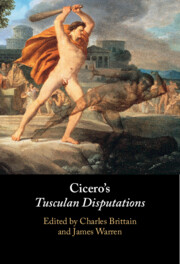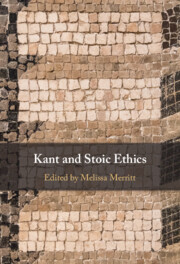Refine search
Actions for selected content:
129 results
Chapter 7 - The Role of Magnitude in Stoic Emotions
-
-
- Book:
- Cicero's <i>Tusculan Disputations</i>
- Published online:
- 11 September 2025
- Print publication:
- 18 September 2025, pp 121-141
-
- Chapter
- Export citation

Cicero's Tusculan Disputations
-
- Published online:
- 11 September 2025
- Print publication:
- 18 September 2025
Introduction
-
-
- Book:
- Kant and Stoic Ethics
- Published online:
- 18 July 2025
- Print publication:
- 07 August 2025, pp 1-10
-
- Chapter
- Export citation

Kant and Stoic Ethics
-
- Published online:
- 18 July 2025
- Print publication:
- 07 August 2025
Chapter 8 - Virtue and Happiness
-
-
- Book:
- The Cambridge Companion to Marcus Aurelius' <i>Meditations</i>
- Published online:
- 02 July 2025
- Print publication:
- 17 July 2025, pp 152-171
-
- Chapter
- Export citation
Chapter 3 - Marcus Aurelius and the Earlier Stoic Tradition
-
-
- Book:
- The Cambridge Companion to Marcus Aurelius' <i>Meditations</i>
- Published online:
- 02 July 2025
- Print publication:
- 17 July 2025, pp 47-64
-
- Chapter
- Export citation
Chapter 5 - Body, Mind, Soul, and Self
-
-
- Book:
- The Cambridge Companion to Marcus Aurelius' <i>Meditations</i>
- Published online:
- 02 July 2025
- Print publication:
- 17 July 2025, pp 82-108
-
- Chapter
- Export citation
Chapter 1 - Marcus Aurelius
-
-
- Book:
- The Cambridge Companion to Marcus Aurelius' <i>Meditations</i>
- Published online:
- 02 July 2025
- Print publication:
- 17 July 2025, pp 9-25
-
- Chapter
- Export citation
Chapter 2 - The Form and Function of the Meditations as Ethical Self-Cultivation
-
-
- Book:
- The Cambridge Companion to Marcus Aurelius' <i>Meditations</i>
- Published online:
- 02 July 2025
- Print publication:
- 17 July 2025, pp 26-46
-
- Chapter
- Export citation
Chapter 11 - Marcus Aurelius among the Psychotherapists
-
-
- Book:
- The Cambridge Companion to Marcus Aurelius' <i>Meditations</i>
- Published online:
- 02 July 2025
- Print publication:
- 17 July 2025, pp 214-234
-
- Chapter
- Export citation
Chapter 7 - Ethics and Natural Philosophy in Marcus Aurelius
-
-
- Book:
- The Cambridge Companion to Marcus Aurelius' <i>Meditations</i>
- Published online:
- 02 July 2025
- Print publication:
- 17 July 2025, pp 132-151
-
- Chapter
- Export citation
Chapter 9 - Human Society and the Cosmic City
-
-
- Book:
- The Cambridge Companion to Marcus Aurelius' <i>Meditations</i>
- Published online:
- 02 July 2025
- Print publication:
- 17 July 2025, pp 172-196
-
- Chapter
- Export citation
Chapter 6 - Value Judgements and Emotions
-
-
- Book:
- The Cambridge Companion to Marcus Aurelius' <i>Meditations</i>
- Published online:
- 02 July 2025
- Print publication:
- 17 July 2025, pp 109-131
-
- Chapter
- Export citation
Chapter 10 - The Early Modern Reception of the Meditations
-
-
- Book:
- The Cambridge Companion to Marcus Aurelius' <i>Meditations</i>
- Published online:
- 02 July 2025
- Print publication:
- 17 July 2025, pp 197-213
-
- Chapter
- Export citation
Chapter 4 - Nature, Providence, and Fate
-
-
- Book:
- The Cambridge Companion to Marcus Aurelius' <i>Meditations</i>
- Published online:
- 02 July 2025
- Print publication:
- 17 July 2025, pp 65-81
-
- Chapter
- Export citation
Chapter 3 - Turbulent Worlds
-
- Book:
- Ovid and Plato
- Published online:
- 19 June 2025
- Print publication:
- 03 July 2025, pp 43-60
-
- Chapter
- Export citation

The Cambridge Companion to Marcus Aurelius' Meditations
-
- Published online:
- 02 July 2025
- Print publication:
- 17 July 2025
Buddhism and Disasters: From World War II to Fukushima
-
- Journal:
- Asia-Pacific Journal / Volume 10 / Issue 11 / March 2012
- Published online by Cambridge University Press:
- 07 May 2025, e8
-
- Article
-
- You have access
- Open access
- Export citation
Chapter 3 - The Politics of Prudence
-
- Book:
- Schopenhauer's Politics
- Published online:
- 09 January 2025
- Print publication:
- 23 January 2025, pp 100-128
-
- Chapter
-
- You have access
- Open access
- HTML
- Export citation
Chapter 5 - ‘The Sentiments of Sects’
- from Part II - Philosophy
-
-
- Book:
- Hume's <i>Essays</i>
- Published online:
- 02 January 2025
- Print publication:
- 09 January 2025, pp 92-107
-
- Chapter
- Export citation
